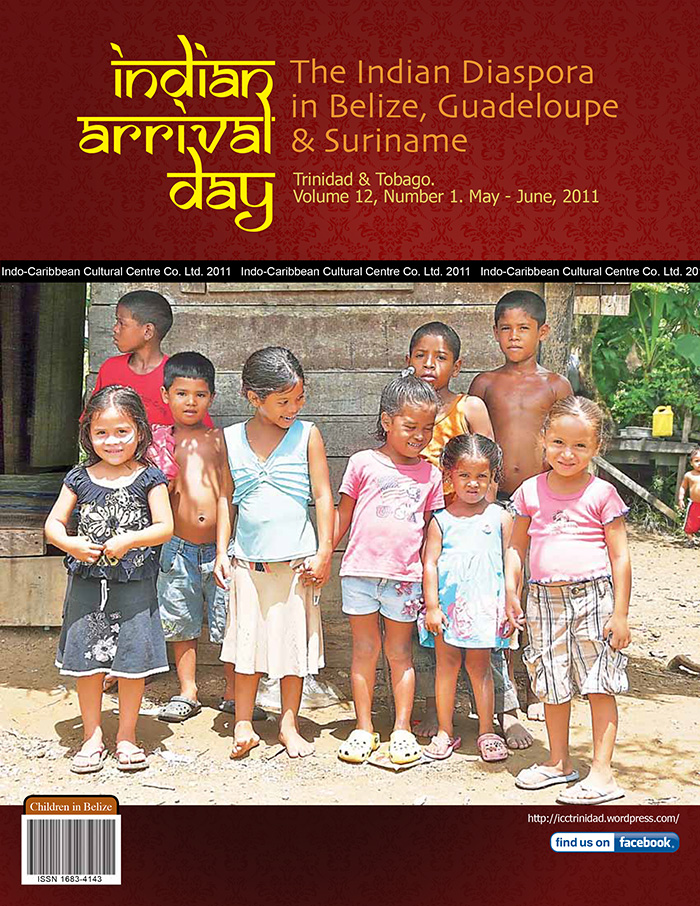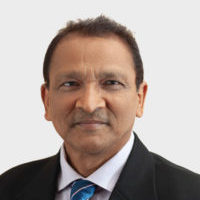
Indian Arrival Day commemorative magazine 2011
Indo-Caribbean Cultural Centre Co Ltd (ICC) is proud to announce the publication of its latest magazine commemorating Indian Heritage Month (May 2011) in Trinidad and Tobago (Caribbean). The theme of the magazine which marks the early arrival of East Indians/South Asians from India to Trinidad (1845-1917) is “The Indian Diaspora in Belize, Guadeloupe & Suriname.”
Belize is located in Central America, Guadeloupe in the Northern Caribbean and Surname in South America. Belize is English-speaking, Guadeloupe is French-speaking and Suriname is largely Dutch-speaking. Yet, all three countries belong to the Caribbean and have descendants of East Indian indentured immigrant labourers domiciled in them.
Indians in Belize comprise four percent (7,000 persons) of the population, Guadeloupe, eight percent (30,000), and Suriname, 37 percent (172,200). The Indians in Belize have lost almost all of their traditional culture, Guadeloupe still maintains some, while Suriname, has managed to preserve a rich Indian cultural heritage. If there is one country in the Western World that can be labelled “Little India,” it is Suriname. Interestingly, Belize and Guadeloupe are longing to re-discover and re-claim their Indian history, heritage and culture. Both countries are looking towards Trinidad for inspiration, interaction, support and sustenance.
Read Online
May-June 2011
11 x 8 ½ inches
80 pages with advertisements and articles
ISSN 1683-4143
Glossy pages and cover
TABLE OF CONTENTS
- About Indian Arrival Day in Trinidad and Tobago
- Belize and Guadeloupe are looking towards Trinidad - Editorial
- Greetings from the Prime Minister of Trinidad and Tobago,
- The Honourable Kamla Persad-Bissessar
- Greetings from the Minister of the Arts and Multiculturalism,
- The Honourable Winston Gypsy Peters
- Greetings from the High Commissioner of India,
- His Excellency Malay Mishra
- Belize: Indian migrants to Belize came from India, Jamaica and Guatemala.
- Belize: There are no native Hindus in Belize, not even in Calcutta village.
- Belize: Indians are eager to recover something of their lost Indianness.
- Belize: Maya Indians prepare and sell curry to East Indians.
- Belize: The Indian-owned, James Bus Line, is the largest private bus service.
- Belize: The Indian Museum is the first of its kind in the Caribbean.
- Belize: The tomb replica in Hosay/Muharram represents the Ark of the Covenant.
- Belize: It is rich with Indian folk tradition of herbal medicine and ancient folktales.
- Belize: Food and kitchen utensils are enduring symbols of Indian identity.
- Belize: Indians may be seeking marriage partners in the Indian Diaspora.
- Belize: Choka is made with many vegetables, including jhingi and baigan.
- Belize: The foreign Indian business community treat local Indians as outcasts.
- Guadeloupe: More than half of the Indian labourers died during indentureship.
- Guadeloupe: Henri Sidambarom is considered the father of Indians in Guadeloupe.
- Guadeloupe: Promoters of Indian culture belonged to the middle and upper classes.
- Guadeloupe: There are more than 500 Hindu temples in Guadeloupe.
- Guadeloupe: Indian worship is a mixture of Hindu, Muslim and Christian rites.
- Guadeloupe: Hindus in Guadeloupe resurrected, adapted and created new deities.
- Guadeloupe: Offering an animal is considered symbolic of the body and blood of Christ.
- Guadeloupe: The national flag is converted into a jhandi.
- Guadeloupe: Indians have invented moltani [curried goat-head soup]
- Guadeloupe: Indians drink French red wine with their curried dishes.
- Guadeloupe: Indians often say, “I am going to a Monday.”
- Guadeloupe: Indians have dual identities as Christians and Hindus.
- Suriname: In 1667, the British exchanged Suriname for New York
- Suriname: Jamaica received more indentured immigrants than Suriname.
- Suriname: All Indians refer to themselves as Hindustanis.
- Suriname: There are 11 radio and 7 TV stations broadcasting primarily in Hindi.
- Suriname: From the youngest to the oldest, all Indians speak Hindi/ Sarnami.
- Suriname: Roopram Roti Shop is modeled after McDonalds and Subway.
- Suriname: Indian males are featured regularly in advertisements, unlike in Trinidad.
- Suriname: In Nickerie, thousands of acres of rice are cultivated.
- Suriname: Suriname has more temples and mosques per capita than Trinidad.
- Suriname: Mother Ganga is often portrayed sitting on an alligator or crocodile.
- Suriname: Mosques are larger, higher and more colourful than in other countries.
- Suriname: The Lalla Rookh Complex is a major cultural and educational centre.

is a full-time anthropologist at the University of Guyana (UG) and Fellow of The Eccles Centre for American Studies, British Library (2022-23). He is a former Assistant Professor at the University of Trinidad and Tobago (UTT). He obtained his Ph.D. in Anthropology from the University of Florida (UF). As a doctoral student, he won a Florida Caribbean Institute Award, an A. Curtis Wilgus Grant, and an Organization of American States (OAS) Fellowship.
Mahabir received a National Award (Hummingbird Silver Medal) for his contribution to education in his country in 2011. He was among 50 recipients who received a Distinguished Alumni Award from the UWI Alumni Association.
Mahabir is the author of 12 books to date.
